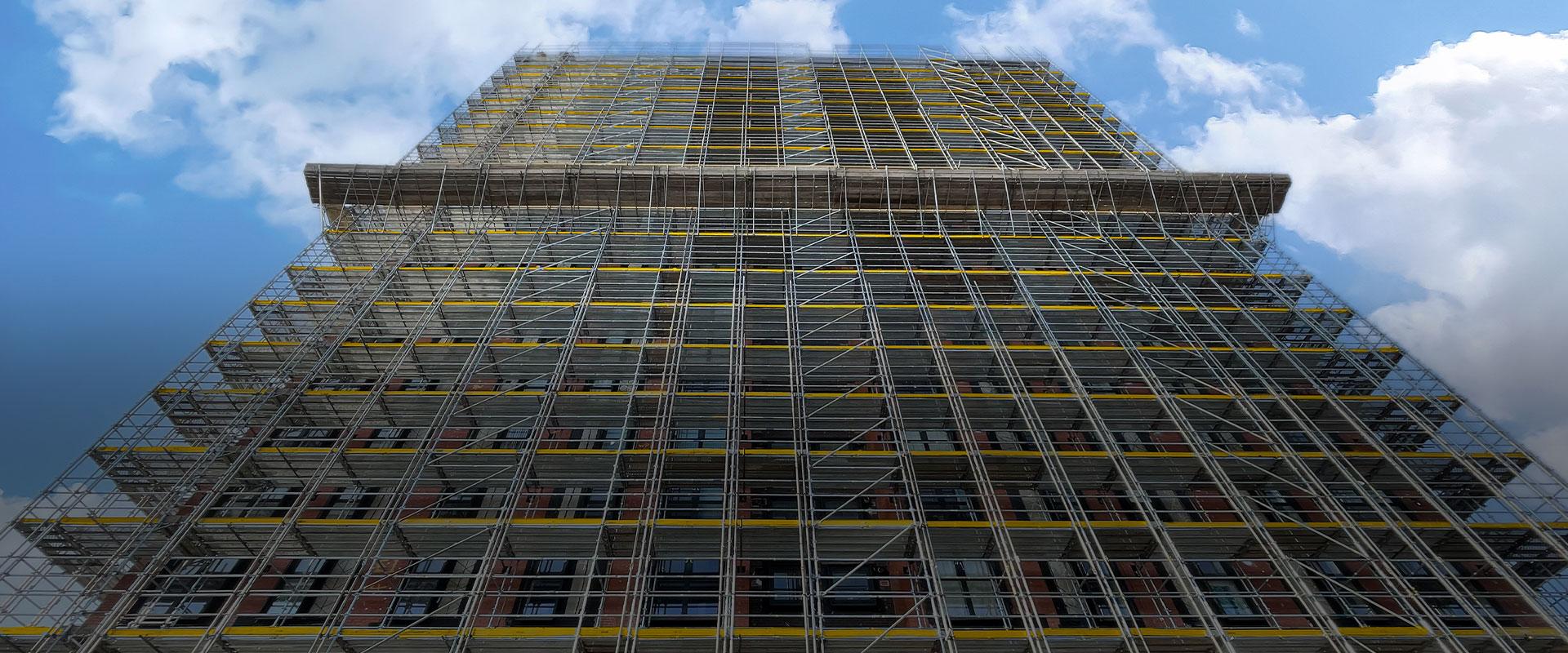Dependable Domestic Scaffolding for Homeowners in Need of Safe Renovations
Dependable Domestic Scaffolding for Homeowners in Need of Safe Renovations
Blog Article
A Comprehensive Overview to the Essential Attributes of Scaffolding in Modern Building And Construction
The landscape of modern-day building progressively depends on effective scaffolding systems that prioritize efficiency, technology, and security. As jobs expand in complexity, comprehending the vital functions of scaffolding comes to be important for ensuring worker safety and security and maximizing task timelines. This guide checks out various kinds of scaffolding, highlights crucial safety and security attributes, and examines material innovations that add to performance and sustainability. The effects of these components expand far past simple building techniques, motivating a better look at just how they influence total job success and employee health.
Sorts Of Scaffolding
Although scaffolding systems can differ widely in layout and application, they usually drop right into numerous unique groups that deal with different construction requirements - Scaffolding. The most usual kinds include sustained scaffolding, put on hold scaffolding, and rolling scaffolding
Sustained scaffolding is composed of systems sustained by a structure of poles, which provide a raised and steady functioning surface. This kind is generally used for tasks that call for considerable altitude, such as bricklaying or external painting.
Suspended scaffolding, alternatively, is used for projects requiring access to high elevations, such as cleaning or fixing building exteriors. This system hangs from a rooftop or one more structure, permitting employees to lower or elevate the system as required.
Rolling scaffolding features wheels that enable very easy flexibility across a task site. It is specifically helpful for jobs that need regular relocation, such as indoor operate in big spaces.
Each type of scaffolding is created with particular applications in mind, making certain that building projects can be accomplished effectively and efficiently. Comprehending these classifications is critical for selecting the suitable scaffolding system to meet both project requirements and website problems.
Key Safety Attributes
Safety is paramount in scaffolding systems, as the potential dangers linked with functioning at heights can bring about significant mishaps if not properly managed. Key safety and security functions are important to guarantee the health of employees and the honesty of the building site.
First and foremost, guardrails are essential. These barriers supply a physical secure versus drops, dramatically decreasing the danger of severe injuries. Furthermore, toe boards are commonly made use of to avoid tools and materials from diminishing the scaffold, protecting employees listed below.
An additional essential element is making use of non-slip surfaces on systems. This attribute enhances hold, specifically in adverse weather condition conditions, therefore minimizing the probability of slides and drops. Accessibility ladders need to be firmly positioned to promote risk-free entry and exit from the scaffold.
Routine examinations and upkeep of scaffolding systems are also essential. These examinations make sure that all components remain in good problem and functioning properly, attending to any type of wear or damage immediately.
Lastly, proper training for all workers involved in scaffolding procedures is necessary to make certain that they recognize safety and security protocols and can recognize possible hazards. Scaffolding. Jointly, these attributes produce a more secure working atmosphere and dramatically mitigate threats connected with scaffolding
Product Technologies
Improvements in material scientific research have considerably affected the scaffolding industry, enhancing both safety and security and performance in contemporary building. The intro of high-strength steel and aluminum alloys has actually changed typical scaffolding systems. These products are not just lighter, making them less complicated to carry and assemble, but additionally give exceptional load-bearing capacities. This leads to scaffolding structures that can sustain better weights while reducing the threat of collapse.
Additionally, innovative composite products, such as fiberglass-reinforced plastics, have actually emerged as viable options. These products are resistant to deterioration and environmental degradation, thus expanding the lifespan of scaffolding systems, particularly in rough weather problems. The use of such materials contributes to reduce upkeep costs and guarantees regular efficiency gradually.


Design Factors To Consider
Thinking about the complexities of modern-day building jobs, reliable scaffolding style is paramount to making sure both capability and safety and security. Layout considerations should encompass numerous elements, consisting of load capacity, height, and the details demands of the construction website. Each project offers one-of-a-kind challenges, requiring a flexible technique to scaffolding systems that can adjust to varying problems.
Structural integrity is important; therefore, designers need to calculate the lots that the scaffolding will certainly sustain, consisting of employees, products, and tools. The option of materials plays an important duty in ensuring the scaffolding can withstand these lots while staying light-weight and durable. Additionally, the style should allow for easy accessibility and egress, promoting the smooth motion of workers and products.
Safety and security attributes, such as guardrails and non-slip surfaces, need to be included to lessen risks of crashes. The design has to consider the surrounding environment, including nearby frameworks and prospective risks. By resolving these style factors to consider, building firms can boost the performance of scaffolding systems and promote a much safer working environment, inevitably contributing to the total success of the task.
Upkeep and Evaluations
The performance of scaffolding systems prolongs past preliminary design and execution; ongoing upkeep and normal evaluations are important to ensuring their proceeded efficiency and security throughout the duration of a task. Routine examinations ought to be carried out by certified workers to recognize any type of signs of wear, damage, scaffold register or instability that can endanger the honesty of the scaffolding.
Maintenance methods must consist of regular checks of structural parts, such as fittings, frames, and slabs, making certain that all aspects continue to be safe and free from corrosion or various other wear and tear. Additionally, the capability of safety and security attributes, such as guardrails and toe boards, should be evaluated to guarantee compliance with safety and security regulations.
Paperwork of all inspections and maintenance tasks is essential for responsibility and regulative compliance. A methodical method to record-keeping not only aids in tracking the problem of the scaffolding yet also supplies needed proof in the event of an occurrence.
Inevitably, establishing an extensive maintenance and evaluation timetable will considerably reduce the risk of mishaps and improve the general security of the building and construction website. By prioritizing these techniques, building and construction supervisors can protect employees and copyright the job's honesty.

Verdict
Finally, the important features of scaffolding in modern-day building encompass a variety of crucial Learn More Here components, including diverse kinds, vital safety systems, material technologies, and thoughtful layout considerations. Highlighting safety with guardrails and non-slip surfaces, alongside advancements in products like high-strength steel, improves both performance and sustainability. Furthermore, regular maintenance and assessments are vital for making certain architectural integrity and safety and security on construction Check Out Your URL sites, ultimately promoting effective project implementation and promoting the health of employees.
The landscape of modern building and construction significantly counts on reliable scaffolding systems that focus on innovation, efficiency, and safety.Innovations in material science have actually considerably influenced the scaffolding industry, boosting both security and effectiveness in modern-day building and construction. On the whole, these material advancements not just improve the efficiency and safety and security of scaffolding systems but likewise line up with the market's push in the direction of sustainability, as many contemporary materials are developed to be extra eco friendly.
Considering the intricacies of modern building projects, effective scaffolding layout is extremely important to ensuring both performance and safety.In conclusion, the necessary features of scaffolding in contemporary building and construction encompass an array of crucial components, consisting of diverse types, essential safety devices, material innovations, and thoughtful layout factors to consider.
Report this page